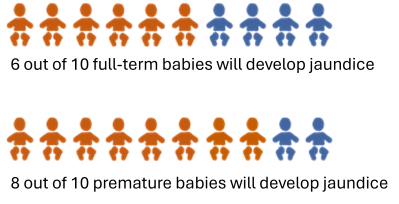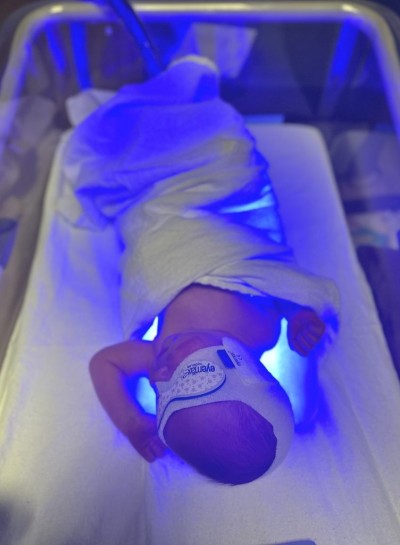Neurodiversity information for parents and young people
About jaundice
Jaundice in newborn babies is common and usually harmless. It causes yellowing of your baby’s skin and the whites of their eyes. It can be more difficult to see in darker skin tones.
Jaundice is the build-up of a substance (called bilirubin) that occurs naturally in our bodies as we process red blood cells. Your newborn’s liver is less developed, so it is less effective at removing this substance from their blood. Other health problems may also cause jaundice, and your baby may require tests.
Jaundice usually develops by day 2 of life. In premature babies this may take longer (sometimes 5 to 7 days).
Jaundice before 24 hours of life can be a sign of an underlying problem and your hospital doctor or midwife may suggest more tests.

Which babies develop jaundice?
The following are more likely to develop jaundice:
- premature babies
- babies who are exclusively breast-fed. (The benefits of breastfeeding still outweigh the risk of jaundice).
- babies who have a previous sibling who had jaundice that needed treatment.
How we assess for jaundice
When looking at your baby, you may notice they have a yellow colour to the skin or eyes. You may also notice a change in the colour of their urine or poo. Your baby may be sleepier or be reluctant to feed. If you think your baby has jaundice, tell a healthcare professional. They will offer guidance on next steps.
To monitor jaundice, we sometimes use a skin test (called a TCB) for babies older than 24 hours and born after 35 weeks gestation. Sometimes we use a heel prick blood test to measure for jaundice and we plot the results on a graph to check if your baby needs treatment.
Phototherapy
Phototherapy is a blue light which helps the liver to break down the bodily substance (bilirubin) causing the jaundice. Your baby will wear a mask to help protect their eyes while they are being treated with the blue light.
During the blue light treatment, you can continue to feed your baby and have short breaks for cuddles. If the jaundice does not improve, we may increase treatment by adding another source of light.
Once phototherapy has been started, we will give your baby regular blood tests to check the treatment is working. When your baby’s levels of bilirubin are low enough, we will stop phototherapy and carry out further blood tests to ensure your baby can stay free of jaundice. Sometimes your baby may need to be re-started on phototherapy.
On rare occasions, if your baby does not respond to phototherapy, there are other treatments which we can discuss with you if we consider them necessary.

How long jaundice lasts
By 2 weeks of age, your baby’s liver is more effective at breaking bilirubin and jaundice will often improve. In breastfed babies, jaundice may persist for up to 12 weeks.
Prolonged jaundice
If jaundice persists for more than 2 weeks (or 3 weeks if your baby was born prematurely), it is important that a healthcare professional carries out tests for other causes. In this situation, your GP or midwife will make a referral to the paediatric Prolonged Jaundice Clinic.
During this appointment we will ask you questions about your pregnancy and baby, and your baby may have more blood tests.
Long term effects of jaundice
For most babies, jaundice gets better with a short course of treatment (or without any treatment) and there are no long term effects.
In a small number of babies with a high or rapidly increasing jaundice level, they may be at risk of a rare brain condition called kernicterus. This is where the bilirubin can cross the blood brain barrier and damage the brain. This can be prevented by effective treatment of jaundice.
More information
NHS on newborn jaundice
NHS on newborn jaundice: kernicterus
NHS on Prolonged Jaundice Clinic
Contact information
If you have questions and your baby is still on the postnatal ward, speak to your midwife.
If you have questions and your baby is already home, phone your community midwifery team. You will have been given their phone number when you were discharged from hospital.